Welcome to the latest selection of recent top articles in the physica status solidi journals. Get a glimpse of our publication spectrum and visit our pages by clicking on any of the DOI links below.
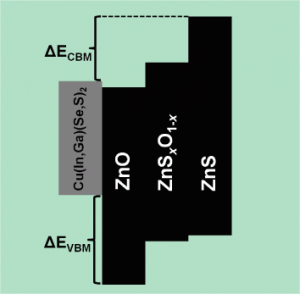
Band alignment at sputtered ZnSxO1–x/Cu(In,Ga)(Se,S)2 heterojunctions
D. Kieven, A. Grimm, I. Lauermann, M. Ch. Lux-Steiner, J. Palm, T. Niesen, and R. Klenk
Band offsets at sputtered ZnSxO1–x/Cu(In,Ga)(Se,S)2 heterojunctions have been investigated by Kieven et al. in the whole composition range x of ZnSxO1–x. The authors found tunable band offsets which suggest that sputtered ZnSxO1–x is suitable as substitution for the CdS buffer and ZnO window layers in standard chalcopyrite-based solar cells. Indeed, working n+-ZnO/ZnSxO1–x/Cu(In,Ga)(Se,S)2 based solar cells were obtained for compositions 0.4 ≤ x ≤ 0.7.
Phys. Status Solidi RRL (2012) DOI 10.1002/pssr.201206195
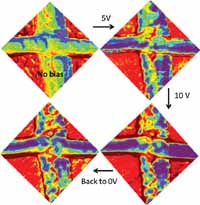
Nanoscale magnetoelectric coupling in multiferroic BiFeO3 nanowires
K. Prashanthi, P. M. Shaibani, A. Sohrabi, T. S. Natarajan, and T. Thundat
Nanoscale magnetoelectric coupling has been observed in multiferroic BiFeO3 (BFO) nanowires synthesized by sol-gel based electrospinning technique. Under externally imposed electric fields these nanowires exhibit a systematic evolution of the magnetic domain pattern as established by magnetic force microscopy, confirming the presence of magnetoelectric coupling. These results promise one-dimensional multiferroic BFO nanowires as a potential candidate for manipulating magnetism through electric field at the nanoscale and provide great opportunities towards magneto-electrically tunable multiferroic devices.
Phys. Status Solidi RRL (2012) DOI 10.1002/pssr.201206135
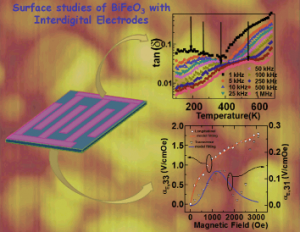
In-plane dielectric and magnetoelectric studies of BiFeO3
Ashok Kumar, J. F. Scott, R. Martínez, G. Srinivasan, and R. S. Katiyar
The in-plane temperature dependent dielectric behavior of BiFeO3 (BFO) as-grown thin films shows diffuse but prominent phase transitions near 450 (±10) K and 550 K with dielectric-loss temperature dependences that suggest skin layer effects. The 450 K anomalies are near the “transition” first reported by Polomska et al. [Phys. Status Solidi 23, 567 (1974)]. The 550 K anomalies coincide with the surface phase transition recently reported by Xavi et al. [Phys. Rev. Lett. 106, 236101 (2011)]. In addition, anomalies are found at low temperatures: After several experimental cycles the dielectric loss shows a clear relaxor-like phase transition near what was previously suggested to be a spin reorientation transition (SRT) temperature (∼201 K) for frequencies 1 kHz < f < 1 MHz which follow a nonlinear Vogel–Fulcher (V–F) relation; an additional sharp anomaly is observed near ∼180 K at frequencies below 1 kHz. As emphasized recently by Cowley et al. [Adv. Phys. 60, 229 (2011)], skin effects are expected for all relaxor ferroelectrics. Using planar interdigital electrodes, Kumar et al. present experimental data and a theoretical model for the in-plane longitudinal and transverse direct magnetoelectric (ME) coefficients. Reasonably good ME coefficients (∼300 mV/Oe cm in transverse and 2 V/Oe cm in longitudinal direction) are measured. Understanding of the in-plane phase transitions and ME behaviour may be helpful to design nanoscale and interfacial devices with high surface to volume ratios.
Phys. Status Solidi A (2012) DOI 10.1002/pssa.201228154
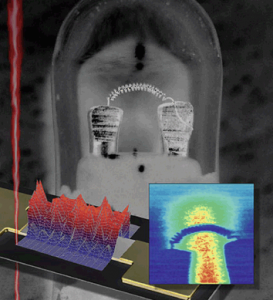
Ultrahigh gain AlGaN/GaN high energy radiation detectors
J. D. Howgate, M. Hofstetter, S. J. Schoell, M. Schmid, S. Schäfer, I. Zizak, V. Hable, C. Greubel, G. Dollinger, S. Thalhammer, M. Stutzmann, and I. D. Sharp
Howgate et al. show that AlGaN/GaN HEMTs exhibit ultrahigh gains under ionizing radiation, yielding extremely large sensitivities in ultralow dose rate regimes. This was proven to be similar for X-rays in the 1–20 keV range and for 20 MeV protons, and can be described by charge separation within the heterostructure. The devices can be structured, as well as miniaturized, using conventional microelectronics techniques that allow for fabrication of integrated two dimensional pixel detectors. Importantly, the HEMT devices function best during small current operation when the channel is completely shut down by, e.g., application of a gate–drain potential. This allows for a low-power unsaturated single electron–hole pair “photomultiplier gain” of 107 at single volt potentials, operated at room temperature.
Phys. Status Solidi A (2012) DOI 10.1002/pssa.201228097
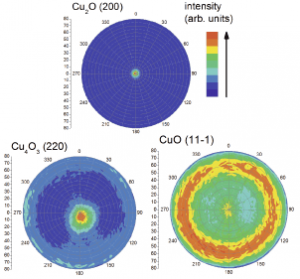
Binary copper oxide semiconductors: from materials towards devices
B. K. Meyer, A. Polity, D. Reppin, M. Becker, P. Hering, P. J. Klar, Th. Sander, C. Reindl, J. Benz, M. Eickhoff, C. Heiliger, M. Heinemann, J. Bläsing, A. Krost, S. Shokovets, C. Müller, and C. Ronning
Copper-oxide compound semiconductors provide a unique possibility to tune the optical and electronic properties from insulating to metallic conduction, from bandgap energies of 2.1 eV to the infrared at 1.40 eV, i.e. right into the middle of the efficiency maximum for solar-cell applications. Three distinctly different phases (Cu2O, Cu4O3 and CuO) of this binary semiconductor can be prepared by thin-film deposition techniques which differ in the oxidation state of copper. Their material properties as far as they are known by experiment or predicted by theory are reviewed. They are supplemented by new experimental results from thin-film growth and characterization, both are critically discussed and summarized. With respect to devices the focus is on solar-cell performances based on Cu2O. It is demonstrated by photoelectron spectroscopy (XPS) that the heterojunction system p-Cu2O/n-AlGaN is much more promising for the application as efficient solar cells than that of p-Cu2O/n-ZnO heterojunction devices that have been favored up to now.
Phys. Status Solidi B (2012) DOI 10.1002/pssb.201248128
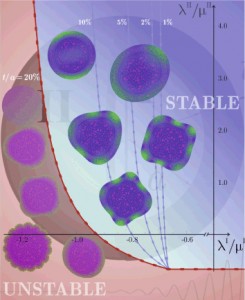
Stability criteria for continuous and discrete elastic composites and the influence of geometry on the stability of a negative-stiffness phase
Dennis M. Kochmann
Stability analysis of elastic two-phase composite materials reveals stable and unstable combinations of the elastic moduli of composite constituents, showing that negative-stiffness phases can be stabilized by a sufficiently stiff and thick matrix phase. Numerical studies confirm the important influence of geometry on stabilizing the unstable. For further details see the article by Dennis M. Kochmann (published online). This article will be part of the Topical Section “Auxetic Materials and Related Systems” to be published in the July 2012 issue of pss(b) which comprises 15 articles highlighting recent progress in research on mechanical metamaterials with emphasis on auxetic systems, i.e., materials exhibiting counter-intuitive negative behaviour (such as negative Poisson’s ratio).
Phys. Status Solidi B (2012) DOI 10.1002/pssb.201084213

















